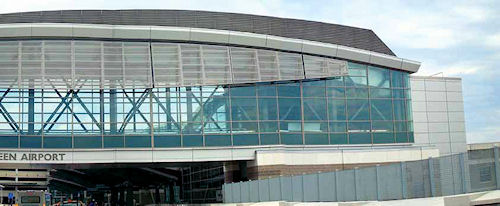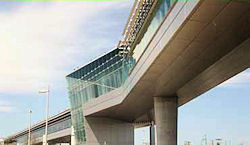New Intermodal Connection Expected to Lure Passengers, Airlines to T.F. Green Int'l

 T.F. Green International Airport (PVD) in Rhode Island recently gained vital infrastructure it had lacked for years: a link to the area's public ground transportation network.
T.F. Green International Airport (PVD) in Rhode Island recently gained vital infrastructure it had lacked for years: a link to the area's public ground transportation network.
When InterLink debuted in late October, the $267 million intermodal facility immediately provided existing passengers easier access to rental cars and train service. It's also, however, expected to attract new customers from the heavily populated area between the airport and downtown Boston, just 45 miles to the north.
 "We share a pretty significant and dense catchment area with [Boston Logan International Airport], and this gives a good portion of our customers in that shared market area a convenient ground transportation option," explains Kevin Dillon, president and CEO of the Rhode Island Airport Corporation, which owns and operates PVD.
"We share a pretty significant and dense catchment area with [Boston Logan International Airport], and this gives a good portion of our customers in that shared market area a convenient ground transportation option," explains Kevin Dillon, president and CEO of the Rhode Island Airport Corporation, which owns and operates PVD.
The new InterLink facility connects passengers to Massachusetts Bay Transportation Authority trains traveling between Warwick, Providence and Boston using Amtrak rails, and eventually Wickford Junction in North Kingstown, RI. The next step is tying in regional bus services to make T.F. Green Airport and the City of Warwick "a true transportation hub for the entire state."
|
Facts & Figures Project: Intermodal Transportation Facility Location: T.F. Green International Airport, Warwick, RI Cost: $267 million Project Partners: RI Airport Corp., RI Dept. of Transportation & Federal Highway Admin. Project Manager: PB Americas Construction Manager: Gilbane Building Co. Designer of Record: Jacobs Engineering Group Rental Car Consortium: Alamo, Avis, Budget, Dollar, Enterprise, Hertz, National, Payless Car Rental, Thrifty & U-Save Project Elements: Terminal end improvements, Skywalk/Skybridge, customer service building & parking garage Primary Benefits: Attracting/accommodating passengers from Boston area; attracting international airlines |
PVD already has Canadian service and charters to the Caribbean, but Dillon says it would like to add scheduled service to the Caribbean and United Kingdom.
Funding for the $267 million project came from Federal Highway Administration grants, a Transportation Infrastructure Finance and Innovation Act loan, special facility revenue bonds, state grants and customer facility charges collected by the rental car companies, reports Dillon.
The Project
Adding InterLink included four major design/construction components: terminal end improvements and a pedestrian walkway, customer service operations building and parking garage. All four were built concurrently, amid an active airport terminal and surrounding roadways.
Ann Clarke, senior vice president of planning, engineering and environmental with Rhode Island Airport Corporation, credits Gilbane, the project's construction manager, with devising a way to build the components simultaneously, within a tight timeframe and set budget. "The amount of coordination that went into making sure that they were all coming in at the same level and they all tied in properly - they did a super job on that," Clarke says.
The airport's new Skywalk - an elevated glass-enclosed structure, 35 feet above the ground - connects the terminal to InterLink's customer service operations building. A series of moving walkways allows travelers to cover the 1,200-foot structure in five minutes - quicker than by vehicle, notes Clarke. The system also eliminates shuttle buses from the roadways, which reduces emissions, she adds.

An enclosed 150-ton bridge dubbed the Skybridge spans the airport's upper-level departure roadway and connects the Skywalk to the terminal at the third floor.
High-efficiency glass in the Skywalk and Skybridge are estimated to save the airport 20% on heating and cooling costs. A sunshade on the southern exposure of the bridge, Skywalk and customer service building is designed to reduce solar glare and heat coming into the building, explains Clarke.
A recycled rubber floor product used on some parts of the project is not only easy on the feet, but also deadens some of the noise, she adds.
The 1 million-square-foot, six-level garage is a pre-cast concrete structure - the pieces for which came from within a 50-mile radius of the airport, Clarke notes. It has parking for about 2,200 rental cars and 660 spaces for rail commuters. Quick-turn facilities on the third, fourth and fifth floors include fueling platforms, vacuums, car wash bays and operation offices. The Massachusetts Bay Transportation Authority platform is also located in the garage.

The customer service operations building houses ten rental car companies that serve the airport. Previously, they were spread throughout the airport or even off-airport because there simply was not space for them.
Some of the debt service for the bonds will be paid for by customer facility charges collected by the rental car companies. "It really was kind of a win-win all the way around," Dillon says. "We took care of the space need, the rental cars got a great new facility to operate from for the long term here at the airport, and we also brought in a funding mechanism as well."
PVD built what Dillon calls the "base building," and the rental car companies fit out their individual spaces.
Centralized Insurance
Using an owner-controlled insurance program (OCIP) is an example of the creative approaches taken on the complex project, Clarke says. Rather than each contractor providing its own worker compensation and liability insurance, she explains, Gilbane acted as the "gatekeeper" with everything wrapped up into one big policy for anyone working on the site.
|
New Interlink infrastructure at T.F. Green Int'l provides a vital connection to the area's public ground transportation. |
Complex, indeed. The project is built over an active rail line and U.S. Route 1, a major thoroughfare through the city and state. "There were so many potentially complex and potentially dangerous situations," Clarke comments. "We also had to deal with some additional liability because of building over the rails, so we felt that it was overall a safer and better [option]. The potential to save money was much greater, and the potential to ensure that there weren't injuries or losses was much greater."
With all the stakeholders involved in the project, Clarke says there was an "unusual" amount of paperwork that had to be signed. Creating a system that didn't slow down the schedule was a challenge, she acknowledges.
Another challenge for the project team was devising temporary paths of travel and related signage. "We have rail passengers that need to get from the terminal down to the rail platform; we have people coming in on buses that need to get to the rail platform; we have people coming in, renting cars. So we had a really interesting time and made many modifications to our sign package to try and make it a seamless path of travel," Clarke recalls.
Making the Connection
Dillon traces the idea for InterLink back to the early 1990s, with the Rhode Island Department of Transportation investigating locations for a train station along the Northeast corridor. But it took successful partnerships between various entities all striving toward a common goal to make it happen, he adds.
The need for an intermodal facility at the airport stemmed from a number of different levels, Dillon relates. "I think the state desired commuter rail connections not only into metropolitan Boston, but also from the southern part of the state up into Providence," he says. "And one of the critical pieces of making that happen was first progressing the rail out to the airport.
"The state brought to the table their commuter rail needs; certainly we brought to the table our intermodal needs and the ground transportation needs for our air customers; and the city was certainly at the table in terms of pushing the project from the economic development standpoint."
Partners on the project include the Rhode Island Airport Corporation, Rhode Island Department of Transportation, the Federal Highway Administration and local and state government entities. Gilbane Building Company served as construction manager, PB Americas as project manager and Jacobs Engineering Group as designer of record.
Regional economic impact from the construction project is estimated at $127 million, including $43 million in construction worker wages. Many of the some 80 subcontractors involved are companies based in Rhode Island. PVD itself has an estimated regional economic impact of about $2 billion per year.
"Intermodalism certainly is a concept that has been around for a long time," Dillon notes, "but hasn't really taken off in a lot of locales." As transportation issues continue to become more critical - especially the rising price of fuel and inability to expand highway systems - he predicts that will change. When that happens, he believes InterLink could serve as a model project for other airports and communities looking to add an intermodal facility.
2022 Charlotte Douglas International Airport Report of Achievement
 Giving back to the community is central to what Charlotte Douglas International Airport and its operator, the City of Charlotte Aviation Department, is about, and last year was no different.
Giving back to the community is central to what Charlotte Douglas International Airport and its operator, the City of Charlotte Aviation Department, is about, and last year was no different.
Throughout 2022, while recovering from the COVID-19 pandemic, we continued our efforts to have a positive impact on the Charlotte community. Of particular note, we spent the year sharing stories of how Connections Don't Just Happen at the Terminal - from creating homeownership and employment opportunities to supporting economic growth through small-business development and offering outreach programs to help residents understand the Airport better.
This whitepaper highlights the construction projects, initiatives, programs and events that validate Charlotte Douglas as a premier airport.
Download the whitepaper: 2022 Charlotte Douglas International Airport Report of Achievement.









